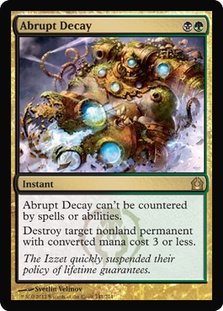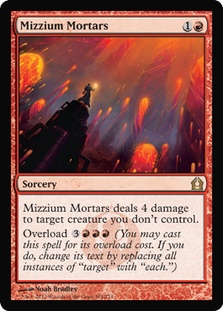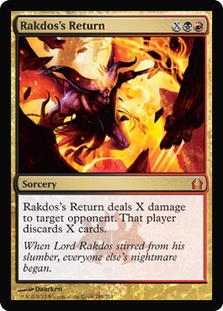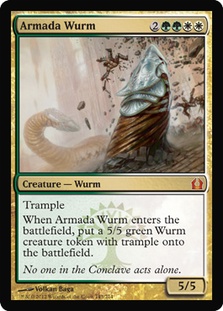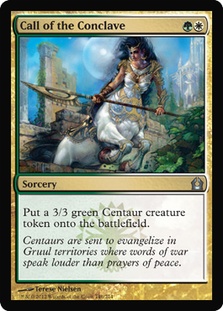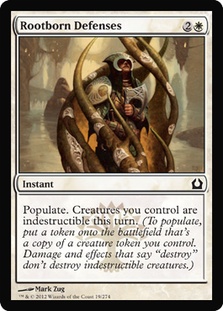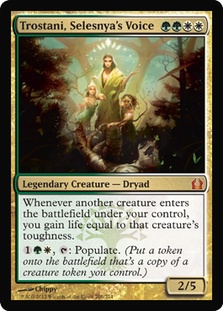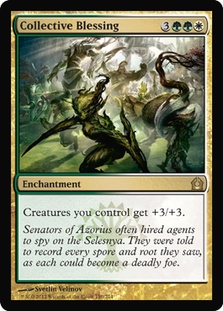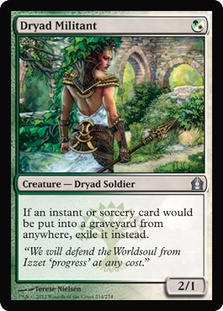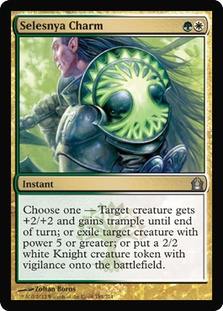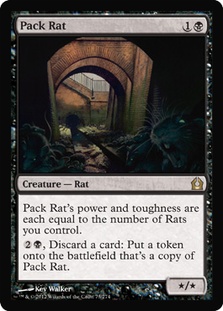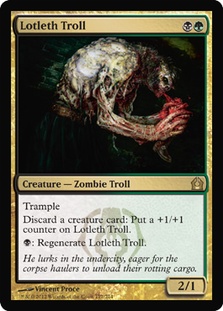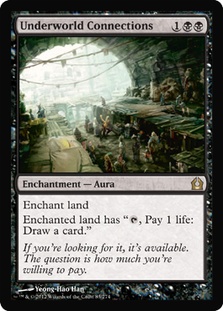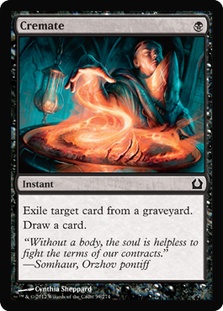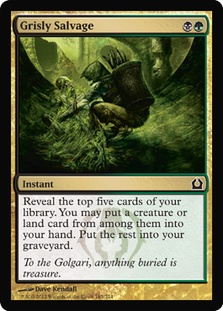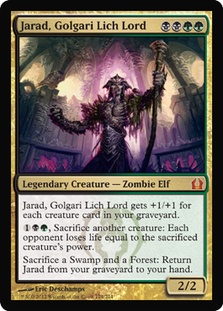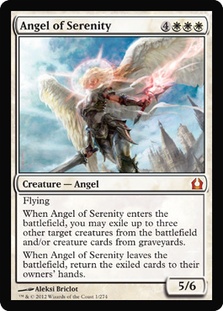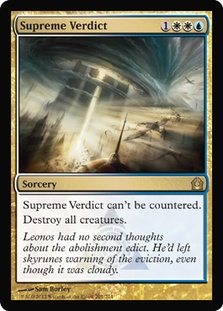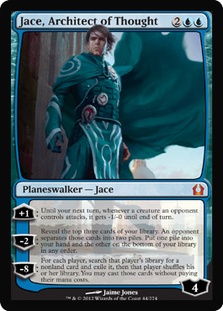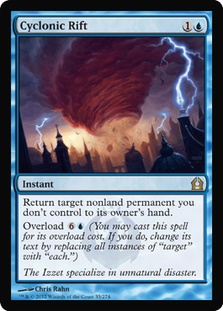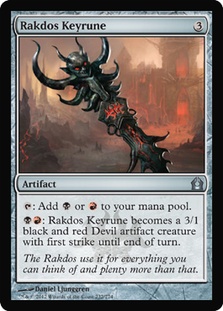Return to Ravnica is in the running for most hyped set of all-time, and with good reason. Gold sets are always super popular, but Ravnica has always been in a league of its own. The return of shocklands, a high tier 1 new Jace, tons of awesome new cards, and one of the most anticipated rotations ever—tournament Magic is a whole new game.
Monday, we discussed Return to Ravnica’s impact on existing archetypes. Today, we will dive into the new decks made possible as a result of Return to Ravnica (though there are so many new decks to explore that this is going to spill well into Friday’s Part 3).
We have to start somewhere, so we might as well start with one of the two early frontrunners of the format, Jund.
Creatures (17)
Planeswalkers (2)
Lands (23)
Spells (19)
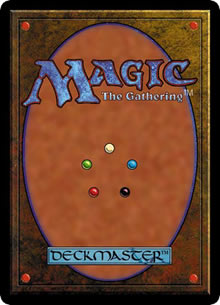
To be fair, I suppose Jund is technically both of the early frontrunners since Zombies is the other and can easily be built Jund, as discussed Monday. As for today’s Jund list, we have a bit more of a “classic Jund deck,” using two-for-ones, cheap removal, and extremely efficient, quality cards.
The new breeds of this powerful archetype are discussed at greater length here; however, I would like to discuss some individual card choices.
To start with, Vraska the Unseen is good, but there is really tough competition at the five spot these days. Thragtusk is on the short list for possible best card in the format, and it is just so hard to justify cutting any. While we can definitely play more than four five-drops, Rakdos’s Return adds a very valuable additional element and Olivia Voldaren is back is big, big way.
Rakdos’s Return isn’t quite Blightning, but it is actually somewhat close and does a few things that Blightning doesn’t. As a Mind Shatter variant, it definitely benefits greatly from Mana Leak’s rotation and Cavern of Souls scaring away some of the meager permission that persists. As a finisher, it gives us more cards we can topdeck to get the reach we need to finish games before they slip away.
As for Olivia, she benefits greatly from the rotation changing the sorts of removal people have access to. Her former banes, Phantasmal Image and Phyrexian Metamorph, are gone with no easy replacements. Vapor Snag is also gone, and Unsummon isn’t going to be nearly as popular. Go for the Throat and Geth’s Verdict are gone, replaced by Ultimate Price and Abrupt Decay, neither of which can actually deal with Olivia. Pillar of Flame and Izzet Charm are going to be some of the most popular, neither of which can deal with Olivia. Oblivion Ring still contains her, as does the new Detention Sphere, but Jund gains Abrupt Decay and possibly Vraska for actual maindeck enchantment removal. Finally, one of the most popular sideboard cards, Celestial Purge, is finally gone.
Not only is Olivia far harder to deal with than she has ever been, but she also has more creature decks to prey on. So many of the obvious week 1 deck ideas people have just fold to an Olivia. She drinks the weak ones’ blood and takes control of the big ones. To top it all off, Consecrated Sphinx, Wurmcoil Engine, and the Titans all rotated, meaning most of Olivia’s competition has skipped town.
Olivia is already starting to gather buzz, but most people haven’t yet fully appreciated just how good this rotation was for her. Olivia will likely be a defining card of the new meta.
While Pillar of Flame and Izzet Charm mean Huntmaster of the Fells is often going to die, he actually benefits a fair bit from the rotation. To begin with, Whipflare, Slagstorm, and Black Sun’s Zenith are all gone. There are less ways to efficiently sweep Huntmaster, not to mention some of the good new removal, like Ultimate Price and Abrupt Decay, being unable to kill him. Plus, the surplus of cheap, efficient beaters makes the two life and two blockers sound pretty darn appealing.
Farseek isn’t new, but Blood Crypt and Overgrown Tomb tremendously impact’s its power level. It is one of the most important cards in the new format and will appear in tons of different decks. You certainly can play Jund without it, but if you do, you better be curving out 1-2-3 with creatures. As for Abundant Growth, well, it is a perpetually overlooked mana fixer that does a mighty reasonable Savage Lands impression. I’d try it more places and more often now.
I like Mizzium Mortars better than Ultimate Price or Abrupt Decay, but there is value in having a diverse mix of removal (particularly some instant speed). Ultimate Price is one step down from Go for the Throat, and Abrupt Decay has exciting applications against Keyrunes and Detention Spheres. So why Mizzium Mortars? A Flame Slash for two mana is not actually that bad a deal, and the option to kick it to build your own miracled Bonfire (without the damage to the face) is huge.
Mizzium Mortars is the exact type of card that most people don’t value what it is giving you appropriately. This is because people are notoriously bad at evaluating opportunity cost. The opportunity cost on Mizzium Mortars is very low since you want two-mana removal spells anyway. Whenever you get to kick it, you are getting a big advantage that you hardly had to pay for. It is possible we should use even more, but it might be so good that it ends up making you want to play less of it. If too many people start playing decks that are good against Mortars, the number of juicy targets will fall.
One memory that keeps coming back to me is the use of Enlisted Wurm in Shards block Jund decks. While no longer technically “Jund,” Enlisted Wurm did give the deck a fair bit of staying power against removal heavy opponents. On the other side of the format, traditional Jund made heavy use of Broodmate Dragon. Where are new Jund’s six-drops?
While it is totally reasonable to say that Thragtusk and Olivia can do the job that needs to be done, another possibility is to add white for Armada Wurm. Once we have the white mana, we might as well use Restoration Angel (improving our Huntmasters, Thragtusks, and Borderland Ranger).
What might such a deck look like?
Creatures (24)
- 4 Borderland Ranger
- 2 Arbor Elf
- 4 Avacyn's Pilgrim
- 4 Huntmaster of the Fells
- 3 Restoration Angel
- 4 Thragtusk
- 3 Armada Wurm
Lands (23)
Spells (13)

As you can see, I went a very ramp-y direction with this one. With so many powerful midrange cards, I just want to cast them early and often. I am definitely not sure we can get away with no spot removal, but it is true that the less removal you play, the better Bonfire is.
Rakdos’s Return is an interesting one, as it can be absolutely fantastic against removal heavy decks and basically anything midrange; however it is pretty awful against Gravecrawler, Reanimator, and Loxodon Smiter. I’d like to start with two, but we may want literally any of the possible numbers.
Armada is more than just 10/10 worth of tramplers over two bodies; he is also the exact perfect size. Mizzium Mortars makes five toughness the magic number, much the way Dismember did for six. Additionally, Armada Wurm has a major advantage over Grave Titan in that a targeted removal spell only hits half of the card. On top of all this, Armada Wurm produces a very large token, making populate cards particularly powerful.
Here is an attempt at G/W Populate:
Creatures (19)
- 4 Arbor Elf
- 4 Avacyn's Pilgrim
- 4 Thragtusk
- 1 Trostani, Selesnya's Voice
- 2 Vitu-Ghazi Guildmage
- 4 Armada Wurm
Planeswalkers (3)
Lands (24)
Spells (14)

Parallel Lives makes all of your token making twice as effective. While this type of effect has always been very popular in casual circles, it is probably written off a little too quickly in many competitive ones. We have to be careful not to end up in win-more space, but the recent massive blow to sweepers (Ratchet Bomb, Pyroclasm, Slagstorm, Black Sun’s Zenith, etc.) coupled with populate bringing tons of powerful new token makers forces us to reconsider just how good the card really is.
Call of the Conclave is pretty close to Watchwolf, which is respectable in its own right. Factor in the ability to populate early reliably and we have an easy hit.
Druid’s Deliverance and Rootborn Defenses are excellent populate tools. Both are very close to good enough even without populate. Once we get a free token on top of everything else, we are talking about a respectable amount of power.
Wait, Druid’s Deliverance and Rootborn Defenses do things you actually want to do? When do you ever play those types of effects?
Well, I certainly would if they were cantrips. Populate isn’t as reliable as cantrip, but it becomes more powerful than it when you are talking 3/3s and bigger.
Druid’s Deliverance is absolutely excellent for racing, and not just as a Fog. Remember, you can be in a race situation with all your guys sideways. When your opponent attacks, you populate and now have a surprise blocker. Not only does your 3/3 eat one of their guys, but you don’t take any damage on the turn and your clock is now faster. We don’t have room for much interaction in this sort of a deck, so a card that can potentially deal with all of their creatures is interesting.
Rootborn Defenses provides another novel effect that does more than the surface would suggest. Yes, it definitely gives you counterplay against sweepers, like Supreme Verdict, Mizzium Mortars, and Bonfire of the Damned; however, it also lets you win creature combat. Bash your guys into theirs, put your Root down, and put your boot down. Even when you are just protecting a guy from a spot removal spell, it is still a two-for-one (saving your guy and making a new one).
I am not sure yet what to make of Vitu-Ghazi Guildmage. Guildmages are notoriously hard to evaluate properly (opportunity cost and all), but this one’s abilities look pretty good. Token making is definitely what we want, and the ability to populate repeatedly and fairly economically is exciting. Unrelated, but there have to be some infinite combos in Modern with this thing and Cackling Counterpart, right?
Trostani, Selesnya’s Voice is an option that is well worth trying. There is a lot of competition at the four-spot, but it might just be that his rate is too good to pass up. Wayfaring Temple, on the other hand, is easier to pass on, though it could still be good if we were fast enough (probably not an Armada Wurm deck).
Another possibility is to splash black for Lingering Souls. Of course, once we do that, Intangible Virtue starts looking appealing. From there, it is a slippery slope before Midnight Haunting and Gather the Townsfolk make their way in. We could replace Thragtusk with Geist-Honored Monk and Armada Wurm with Sorin. Pretty soon, we hardly have any Return to Ravnica in our deck:
Creatures (6)
Planeswalkers (6)
Lands (25)
Spells (24)

I am somewhat hesitant to want to go all in on it. This strategy wasn’t high tier 1 before and doesn’t actually gain all that much. A lot of sweepers are gone, but Detention Sphere is a real pain. Once you start down this path, however, Collective Blessing starts becoming really strong. It is basically Overrun from now on. It doesn’t give trample, but a lot of your tokens fly. It is far better than Overrun against removal heavy opponents, as it makes every one of your cards a lethal threat from now on. It does cost six, however, so we have to be mindful of our curve.
It might also just be better to splash Lingering Souls into the above decklist and stay populate-centric. You could support it off of four Overgrown Tombs and two Isolated Chapels, replacing four Forests and two Plains (maybe a Plains and a Guardian of the Grove). Alternatively, we could squeeze a couple Evolving Wilds and a Swamp in here to go along with four Overgrown Tombs, cutting five Forests, two Plains, and a Guardian of the Grove or something similar.
It might be too greedy to play no removal aside from Garruk. Oblivion Ring is certainly an option, but so are Angel of Serenity, Fiend Hunter, and black spot removal.
Populate is certainly not the only direction we can take G/W. What about a more straightforward beatdown deck? We talked about G/W Humans on Monday, but what if we abandon the tribal theme?
Creatures (28)
- 4 Arbor Elf
- 4 Avacyn's Pilgrim
- 4 Strangleroot Geist
- 4 Silverblade Paladin
- 2 Wolfir Silverheart
- 3 Sublime Archangel
- 3 Dryad Militant
- 4 Loxodon Smiter
Planeswalkers (2)
Lands (22)
Spells (8)

We aren’t talking about a lot of interaction here, but when built right this deck will hit like a truck. Every card in the deck does more damage than its cost, has haste, or makes mana. In addition, we have a few disruptive elements (Dryad Militant against Snapcaster Mage and flashback, Strangleroot Geist against removal, Loxodon Smiter against discard, and tons of fatties against burn). Other fine options for interaction include Garruk Relentless, Oblivion Ring, and Selesnya Charm.
Loxodon Smiter is not the sort of card you just want to throw in the main of random decks, as he is mostly just this donk. However, if you have plenty of other creatures to draw out removal, he is an efficient threat that can trump a lot of boards. Additionally, he really cripples Liliana of the Veil and Rakdos’s Return (happening to be the exact perfect size to kill a Liliana that comes down and immediately goes to four).
In fact, this perfect positioning against Liliana is clearly a safety valve designed by R&D to ensure Liliana-centric decks (perhaps a Jund build) do not spiral out of control. If you are playing some kind of a midrange deck that is having trouble with Liliana, I’d consider boarding a couple of these, though be careful that you don’t ask too much of him. If you get Rakdos’s Returned for four and lose everything, having a 4/4 isn’t really going to save you against a deck of Mizzium Mortars, Abrupt Decay, Liliana, and so on.
Dryad Militant is another interesting one to consider. Just how good is this ability? In Standard, it isn’t really worth spending that much on since she is going to eat a removal spell a fair chunk of the time. We are talking about a Savannah Lions, though, so it’s not like we are really being charged much at all.
It is important to note that when we talk about what we are being charged, we can’t just say, “This guy is a better rate than Savannah Lions or Elite Vanguard, so we aren’t being charged for the ability.” This is because when we talk about what we are charged, the real cost we care about is the opportunity cost, not the mana cost. If we were playing Elite Vanguard before, no problem, an easy swap (unless we have tribal considerations). However, if we weren’t playing it before, we actually need to get more for the cost just to make it playable for us.
Dryad Militant may be somewhat fragile, but she is going to be reasonably disruptive against some opponents. For instance, if you play against a U/W Miracles deck, it can be randomly sweet that she disrupts Think Twice. It is not like they actually have that much early removal. It is also nice that she puts such a respectable clock on them.
Here is the fun thing, though. If you play a turn 1 Dryad Militant and your opponent plays a Pillar of Flame on it, it looks like you both spent a mana and a card, but their Pillar of Flame is exiled, which is invaluable if they also have a Snapcaster Mage.
Not surprisingly, Dryad Militant will likely be a solid role-player in more powerful formats as we begin to transition from “hate bears” to “hate lions.” I wonder if Dryad Militant is really better than just using our own Snapcaster Mages in Modern, but if you just stay Naya, she is a reasonable threat. As for Vintage, how many removal spells are they even playing? As long as you can deal with a Tinker and a Jace the Mind Sculptor, Dryad Militant does pretty good work against Yawgmoth’s Will, though it is a shame she doesn’t interfere that heavily with Dredge or Crucible / Wasteland.
Sublime Archangel often effectively “has haste,” as well as provides a powerful threat in the air if things get murky on the ground. One of the nice things about how big she makes a single creature is how well that works with Ajani, Caller of the Pride or Silverblade Paladin (capitalizing on double strike).
Wolfir Silverheart doesn’t get all that much love anymore due to Thragtusk stealing the spotlight. However, when we are heavy on creatures that people will want to use their removal on, he is a very powerful weapon that hits much harder.
G/W has gained such a variety of new cards worth considering that it remains to be seen what directions people will go most and how hybridized the decks will become. To start with, I’d recommend making the most extreme versions we can then evolving them from there.
On Monday, we talked about Zombies, which is likely to be the tribe to beat in the new format (at least week 1). What about their sister tribe, Vampires?
Creatures (25)
- 2 Vampire Nighthawk
- 4 Bloodthrone Vampire
- 4 Stromkirk Noble
- 4 Bloodline Keeper
- 4 Falkenrath Aristocrat
- 4 Stromkirk Captain
- 3 Zealous Conscripts
Lands (25)
Spells (10)

While the Vampire tribe doesn’t have very many good cheap creatures anymore, it isn’t exactly trying to compete with Zombies for that niche anyway. Instead, we might want to capitalize on Bloodthrone Vampire and Falkenrath Aristocrat as sacrifice outlets to combo with Mark of Mutiny and Zealous Conscripts for the total blowouts. It isn’t just that we can kill anything we want (after hitting our opponents with it), but it is also super sweet against creatures like Thragtusk, which are normally a pain to remove.
This list is surely too slow, which is a common problem when most of our best cards cost four or more. It is tough because Bloodline Keeper is actually an exceptional Lord when you are actually playing Vampires, as you can often flip him the turn after you play him.
One option I did not include is Vampire Nocturnus. He is definitely much more of an aggro card that benefits from cheap Vampires. His rate is definitely exciting, but without fetchlands his ability isn’t as reliable as it once was. Being triple black is not inconsequential now that we have so much desire to play red. Finally, he has to compete with Falkenrath Aristocrat and Bloodline Keeper (not to mention Olivia), making it quite a challenge to find room.
Another black tribe that is probably even more of a long shot but that has chances is Rats. I wouldn’t recommend going Mono-Rat Control or anything, but maybe they can make for a new fringe Zombie variant.
Creatures (34)
- 2 Ravenous Rats
- 4 Diregraf Ghoul
- 4 Typhoid Rats
- 4 Gravecrawler
- 4 Geralf's Messenger
- 4 Pack Rat
- 4 Lotleth Troll
- 4 Drainpipe Vermin
- 4 Rakdos Cackler
Lands (19)
Spells (7)

By not going to “all-in” on the theme, we are actually turning Pack Rat into a reasonably priced threat. We will often have at least one other Rat in play when we play him (which is usually not going to be turn 2), but on our next turn we can threaten to make another Pack Rat before damage, making him a Watchwolf. If the game continues much longer, all of our Pack Rats will become huge, letting us win creature wars. Additionally, it is worth noting that Gravecrawler plus Pack Rat is lots of fun. Dreg Mangler would be in a similar vein if your mana could support it.
With 20 one-drops, we are definitely aiming to come out the gates with a two-power one-drop on turn 1, followed by two more one-drops on turn 2. Our removal is also built for speed, focusing on one-mana removal to try to gain a tempo advantage. We don’t really have a lot of long-game hopes, but by going medium we can rely on Pack Rats and Lotleth Troll to give us chances.
It is not at all clear to me how much mana we should be playing. We have 20 one-drops and a lot of cheap removal, so I’d like to shave even lower than what we are currently at; however, Pack Rats give us excellent ways to use our extra land (and want us to hit that third land drop).
While we are experimenting with romantic fantasies such as tournament viable Rat decks, we might as well take a stab at Mono-Black Control for a change.
This deck still has a lot of holes in it, and it would be nice to find more good cheap spells, as we are still bottlenecked at the four spot. That said, Underworld Connections does give us a reliable source of card advantage that we have been sorely lacking for so long. Sign in Blood and Disciple of Bolas also have card draw to add if we want it.
Underworld Connections and Sign in Blood are both good but have us looking for life gain to help offset them. Tribute to Hunger and Vampire Nighthawk (possibly with Liliana to pump it) are a good start, but neither really has the kind of power that Wurmcoil Engine or Batterskull gave us. Tablet of the Guilds is interesting, but I am a little hesitant since it only gains life off of our black spells (making it worse than Demon’s Horn for us).
What we really want is Thragtusk.
It is interesting to consider what “Mono-Black” even means. After all, our only real payoffs are Mutilate and Liliana of the Dark Realms. Both of these cards would totally function if we splashed a color, thanks to shocklands and Evolving Wilds. For instance:
Creatures (11)
Planeswalkers (2)
Lands (24)
Spells (24)

Not only are we gaining life from our Thragtusks, but we are getting a nice chunk of life from our Disciples as well. Finding the right balance of all of this stuff is tricky, but with so much card draw, we might just want Barter in Blood to give us even more sweepers. As always, the tough part is how many four-drops we want to play.
As you’ve surely noticed, I am a fan of Cremate in heavy black decks. It punishes Snapcaster Mage, flashback, and Unburial Rites, but it is also invaluable against Gravecrawler, Geralf’s Messenger, and Strangleroot Geist. As long as we play with cheap spells that are going to the graveyard, it is a pretty reliable cycler for one mana, which is made even easier if we play Evolving Wilds.
People love to play stuff like Surgical Extraction, but Cremate is actually worth playing main. What could you possibly want more in life than to draw a card?
You may have also noticed my predilection for Dead Weight. Tragic Slip is good, but being able to kill a Diregraf Ghoul or a Rakdos Cackler can make all the difference in the world, not to mention Huntmaster of the Fells or Silverblade Paladin.
On the topic of B/G, another archetype that we should consider is that of self-mill (Dredgevine). The line between this archetype and Zombies will often be fuzzy and there are a number of reasons to splash another color, but here is a starting point:
Creatures (25)
- 4 Arbor Elf
- 4 Splinterfright
- 4 Gravecrawler
- 4 Ghoultree
- 2 Jarad, Golgari Lich Lord
- 3 Dreg Mangler
- 4 Lotleth Troll
Lands (22)
Spells (13)

This deck rides the line between aggro and combo, putting out lots of economical threats while dredging itself to set up even bigger and more powerful threats. Mulch, Grisly Salvage, and Splinterfright give us a reasonable but not overwhelming amount of dredge, while Gravecrawler, Dreg Mangler, Ghoultree, Gnaw to the Bone, and Jarad give us plenty of other ways to capitalize on it.
Lotleth Troll is a very important addition to this deck, as it helps with the tempo nature of the deck but can also dump plenty of creatures into your yard to get things started (such as the first point of toughness for your Splinterfright). It is possible that we want Boneyard Wurms in here, as well but I am somewhat reluctant without more dredging. What I’d really like to see in here is Tracker’s Instincts.
Grisly Salvage is a fantastic tool in these decks, digging you deeper than Forbidden Alchemy and for less mana. The above list may or may not prove a dead end, but make no mistake: Grisly Salvage is the real deal. It is one of the stronger cards in the set and will spawn a number of new archetypes around it (like Forbidden Alchemy did).
It is worth noting that Grisly Salvage does not require you to actually take a creature if you don’t want to. This was not the case with Tracker’s Instincts, which sometimes forces you to take a creature that you actually just want in your yard for your Splinterfright. I’d also note that Grisly Salvage is so good that it will actually show up in some places that are not dedicated linear decks. Milling yourself for four or five is really strong, but this card is actually closing in on Impulse quality selection.
In the deck above, 47/60 of the cards are legal to hit with your Grisly Salvage. That means on the average, you will have your choice of four cards to choose from (the same selection offered by Impulse). Now, there is some distortion caused by not being able to hit spells, but this is more than made up for if you hit even a single graveyard card. Additionally, it is not like Impulse is fair. The biggest thing holding Grisly Salvage back, of course, is that the proper tools exist to defend against it if it gets out of hand (like Cremate and Tormod’s Crypt).
Of course, we can actually push Grisly Salvage much further than this if we like. For instance:
Creatures (17)
Lands (23)
Spells (21)

Now, it is not at all certain that this deck’s mana is ready for prime time yet, but the combo is deceptively strong. See, the whole Ghoultree thing is actually just a backup plan. The main way we win is with Laboratory Maniac.
We are just going to dredge and dredge and dredge until we can use Memory’s Journey to set up Laboratory Maniac with Runic Repetition for backup. We play the Maniac with zero or one cards in our deck then Desperate Ravings for the win. There isn’t even all that much instant speed removal, but should we face some, we can just pass the turn with the Maniac in play. We will win on our draw step, but if they try to kill him, we can just flashback our Ravings in response.
Even if things go horribly wrong, we can bail ourselves out with the Memory’s Journey that we got from our Runic Repetition then set it all back up again next turn. Even if we don’t want to try to combo them out, Runic Repetition plus Memory’s Journey lets us stock our deck with whatever we want so that we are drawing Ghoultrees, Kessig Wolf Run, Snapcaster Mage, Blasphemous Act, or whatever else we want. Even just looping Gnaw to the Bone and Blasphemous Act can be game winning, alternating between gaining 30 and sweeping the board.
Of course, another direction to take the graveyard shenanigans is that of Reanimator. Brad Nelson highlighted a bit more of a “Frites” style Reanimator here. I still don’t have a list I like at all, so I am going to have to keep working on it for Friday. That said, here is a real rough sketch that demonstrates some of the ideas I have been thinking about.
Creatures (10)
Lands (23)
Spells (26)

Angel of Serenity seems like the Reanimator target of choice, letting you completely take over a board, giving you a backup plan going long, and providing a source of card advantage by letting you target Augur of Bolas from your graveyard.
Grisly Salvage is less good when you have fewer creatures you actually want to hit, but hitting land while dredging is still appealing.
Izzet Charm provides some much-needed interaction while also serving as another discard outlet (this one at instant speed for the full-on surprise).
Supreme Verdict may be out of place here, but I can’t help but suspect we are going to get run over if we don’t have something in place to buy us the time we need.
There are so many new decks possible that we are going to have to pick this brew session back up on Friday. Before we go, however, here is a Grixis deck for the road.
Creatures (4)
Planeswalkers (8)
Lands (25)
Spells (23)

To start with, Olivia is back to being a star. Niv-Mizzet is real good, however, so I’d want to start with a split. If you untap with him, you are in really good shape, drawing a flurry of cards, and if you have a lot of mana, you can still draw cards with him before he dies. Additionally, Liliana’s discard ability will often knock removal out of opponents’ hands.
The tag team of Jace and Tamiyo is surely going to be the backbone of a lot of new control decks, so no surprise there. I’d love to include a Nicol Bolas, but there is a good chance that he is aiming too high (despite how powerful he is). Diabolic Revelations is also a reasonable kill card (perhaps playing two copies and an Elixir of Immortality). Griselbrand is quite big but also an option. Most likely, however, we just want more low to the ground stuff, buying us more time to let Liliana, Jace, and Tamiyo take over.
Some people seem to really like Thoughtflare, but it is kind of straightforwardly a worse Desperate Ravings. The discard is choice instead of random, but you have to pay for it all at once, which is a massive cost. Additionally, you lose all the synergies with Liliana, Forbidden Alchemy, Izzet Charm, and other Ravings. That said, it is a better Snapcaster target, but that is pretty expensive. Firemage’s Foresight is sweet, but it is probably a bad Diabolic Revelations.
Cyclonic Rift is much more appropriate for a control deck than a Delver deck. First of all, the extra mana really is important. Besides, it costs a lot to kick a Rift, and not every Delver deck is going to be able to handle that. More importantly, though, Unsummon can actually hit your own guys, unlike the Rift. A deck like Delver highly values being able to use Unsummon to reset Snapcasters and Augurs and even just to save a creature in the right spot. Cyclonic Rift, like all of the overload cards, can’t target your stuff.
Pillar of Flame is still the best we can do, as it only costs one. In fact, all I want are more Shocks, so I’d rather Dead Weight than Ultimate Price. Mizzium Mortars’ kicker is too good to pass up, of course, but we have a lot of late game already. Of course, Augur of Bolas is a demanding fellow, so I’d like to see if we can get away with Tragic Slip in place of Dead Weight. We might not be able to, but it does improve our chances of hitting.
Having one Dreadbore and one Rakdos’s Return gives us a couple of hard answers to planeswalkers (in addition to our own copies), which is very relevant when we have all of this dig (Augurs, Ravings, Charms, Alchemy, etc.). Rakdos’s Return also gives us an invaluable weapon against midrange and control decks to help make up for the lack of permission. It is possible that we either need a couple of counterspells (beyond the Izzet Charm) or we need a second Rakdos’s Return.
Rakdos Keyrune is my favorite of the bunch, as it can completely take over some boards while providing much need acceleration and making for a great tempo play with Pillar of Flame, Tragic Slip, or Dead Weight. I am much less sold on Magmaquake, which has the potential to be awkward with our walkers. Rolling Temblor avoids this, but it is nice to have more instant speed interaction, plus it does give us a powerful weapon to use against other walkers (particularly Garruk).
The sideboard is pretty hodge-podge, but I would like to note that Slaughter Games might be particularly valuable. I wouldn’t be surprised if a reasonable number of people have a lot of trouble winning after having their Angels of Serenity slaughtered.
Ok, I’m out for today. Thank you for all of the suggestions on what to cover today. Please feel free to let me know what you’d like to see Friday (besides red aggro and more control, which are at the top of the list…)
See you then!
Patrick Chapin
“The Innovator”
 |
The first rule of Dimir Guild is you do not talk about Dimir Guild. The second rule of Dimir Guild is you do NOT talk about Dimir Guild. My official response? Izzet and proud… |


